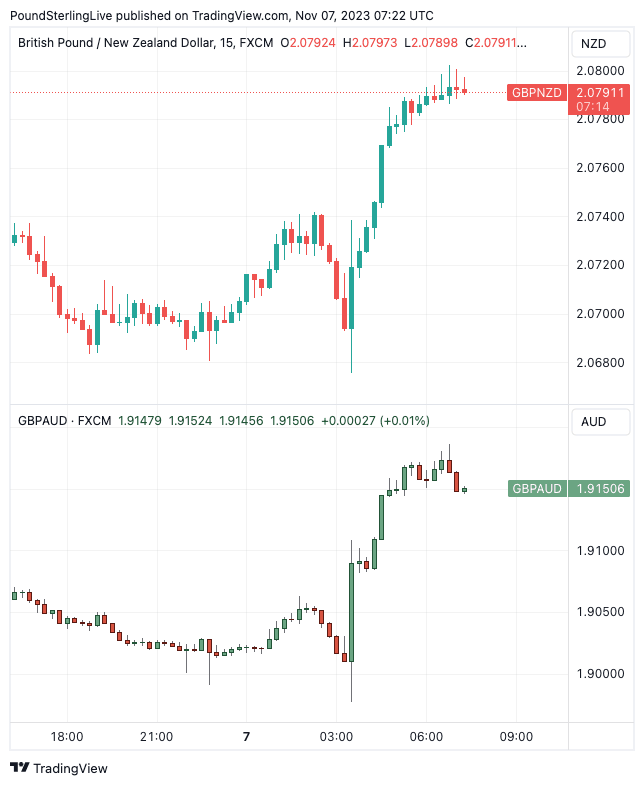New Zealand Dollar Slides On Aussie Rate Decision, Mixed Chinese Trade Numbers
- Written by: Gary Howes

Image © Adobe Stock
The New Zealand Dollar has fallen in value, dragged lower by its trans-Tasman neighbour and a mixed set of trade numbers from China, where the post-Covid recovery remains on shaky ground.
NZD tracked the Australian Dollar lower after the Reserve Bank of Australia (RBA) raised interest rates following an extended pause but released guidance that lowered the odds of a further hike.
The NZ Dollar decline following a change in guidance at the RBA suggests investors now see the odds of another New Zealand rate hike as also having fallen, owing to the interconnectedness of the two Antipodean economies.
The strong correlation between AUD and NZD against major FX peers is confirmed by the charts below:
The above chart shows the GBPNZD exchange rate (top) chart tracking the post-RBA decision move in GBPAUD in the lower panel.
The follow-through price action is notable and suggests the Kiwi can continue to track the fortunes of the Aussie over the coming days.
The Pound to New Zealand Dollar exchange rate has risen half a per cent today to reach 2.08 at the time of writing. The Euro to New Zealand Dollar rate is up by a similar margin at 1.8055, the New Zealand Dollar to U.S. Dollar rate is down two-thirds of a per cent at 0.5926.
Compare GBP to NZD Exchange Rates
Find out how much you could save on your pound to New Zealand dollar transfer
Potential saving vs high street banks:
NZ$53.50
Free • No obligation • Takes 2 minutes
Although the RBA hiked 25bp, as was largely expected, the policy statement was somewhat dovish, suggesting no strong desire to see further hikes.
"Whether further tightening of monetary policy is required... will depend upon the data and the evolving assessment of risks," said the RBA. This contrasts with previous guidance that "further tightening may be required".
The market reaction signals investors reckon the Reserve Bank of New Zealand (RBNZ) might be less inclined to raise interest rates again in the event that the RBA has completed the cycle, a view that is underpinned by New Zealand's somewhat softer economy.
New Zealand's labour market is 'loosening' as more workers seek jobs, in turn lowering pressures on wages, which is considered a deflationary impulse by central banks.
Indeed, New Zealand unemployment rose to 3.9% from 3.6% in the third quarter, prompting a lowering in expectations for further RBNZ rate hikes.
"It is still a relatively low rate, but it is steadily tracking up. Wage growth also slowed. From the RBNZ's point of view, the outcomes reinforce that inflation pressures are gradually moderating. It is still going to take some time for inflation to get back into the target band, but the RBNZ will feel less on tenterhooks now," says Nick Tuffley, Chief Economist at Auckland Savings Bank.
Some positive news for the NZ Dollar could be found in the news that Chinese imports recovered more than expected in October (+3.0% y/y, consensus -4.8%), suggesting that the recent policy easing supports domestic demand.
This can support New Zealand's consumer-facing export sector, such as the milk and lamb industries.
But any bullish enthusiasm for China-lined currencies, such as the NZD, was tempered by the news that Chinese exports fell more sharply than anticipated (-6.4% y/y, against consensus expectations for -3.3%), as tightening financial conditions are restricting demand elsewhere.
The overall trade balance weakened as the surplus declined to USD56.5BN (from USD77.7BN).
All eyes now turn to China's inflation numbers, due for release on Thursday, which will give another indication of how strong the underlying economy was in October.
Compare GBP to NZD Exchange Rates
Find out how much you could save on your pound to New Zealand dollar transfer
Potential saving vs high street banks:
NZ$53.50
Free • No obligation • Takes 2 minutes





